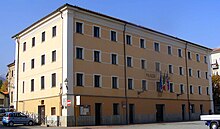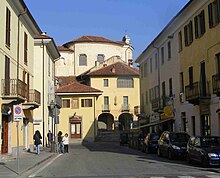Cumiana
| Cumiana | ||
|---|---|---|

|
|
|
| Country | Italy | |
| region | Piedmont | |
| Metropolitan city | Turin (TO) | |
| Coordinates | 44 ° 59 ′ N , 7 ° 22 ′ E | |
| height | 377 m slm | |
| surface | 60 km² | |
| Residents | 7,876 (Dec. 31, 2019) | |
| Population density | 131 inhabitants / km² | |
| Post Code | 10040 | |
| prefix | 011 | |
| ISTAT number | 001097 | |
| Popular name | Cumianesi | |
| Patron saint | Virgin Mary's birth | |
| Website | Cumiana | |
Cumiana ( Piedmontese Cumian-a ) is a municipality with 7876 inhabitants (as of December 31, 2019) in the Italian metropolitan city of Turin (TO), Piedmont region .
Cumiana is a member of the mountain commune Comunità Montana Pinerolese Pedemontano . The neighboring municipalities are Giaveno , Trana , Piossasco , Pinasca , Volvera , Pinerolo , Frossasco , Cantalupa , Airasca and Piscina . The municipality covers an area of 60 km². The place is under the patronage of the Birth of Mary .
history
The first mention of the place as "Cominana" took place in a document from the year 810, the Donazione di Teutcario . With this a donation was made to all lands between Montegrosso and the rock of Bess in favor of the Novalesa monastery in Val di Susa . Teutcarius was an Alamannic warrior - he calls himself "alamannus" - who had come to the country more than a decade earlier. He and his wife Ricarda bequeathed their property to the monastery. In the 10th century the place and its inhabitants went to the Marquis of Susa, then in 980 to the Orsini-Falconieri, the Signori of Rivalta (980), vassals of the bishops of Turin. Through the marriage between Adelheid von Susa and Otto von Savoyen-Moriana, the region came to the Margraves of Turin, after whose disintegration from 1091 the place fell back to the Signori von Rivalta, who had meanwhile become vassals of the Savoyards. When Friedrich Barbarossa moved to Italy, they were considered allies of the Pope. As a result, their castle was looted and torn down in 1176.
In 1239 Amadeus IV of Savoy acquired part of the Rivalta area, and in 1242 another part went to his brother Tommaso II , apart from the Marsaglie. After repeated disputes, Amadeus V (1285-1323) succeeded in stabilizing the rule. Finally, in 1291, he managed to acquire the rest of the Cumiana area, namely the Marsaglie area. In 1294 he left Piedmont to his nephew Filippo, the eldest son of Tommaso III. , with which the line of the Savoia-Acaia began (1294-1369). They resided in Pinerolo , while Cumiana Castle often served them as a prison. Giacomo d'Acaia, the son of Tommasos, tried to make himself independent of the predominance of the main line, finally Amadeus VI moved. from Savoy to war against him in 1356, during which the Cumiana castle was conquered in 1359. Giacomo's son Filippo II took up the fight, eventually even against the will of his father, but was defeated. Cumiana was besieged again in 1368 during the fighting.
Even before the end of the Acaia line in 1418, Cumiana was already in the possession of the Canalis family, who had acquired it from the Acaia on August 24, 1366 for 10,000 gold florins. The Canalis were influential notaries and legal advisers at the court of the Acaia princes in Pinerolo. It dominated the fate of Cumiana until it died out in 1801. Now disputes between the new masters and the emerging commune were in the foreground. On November 6, 1429 the so-called affrancamento was signed. This allowed the municipality to independently levy taxes on economic activities. The one hit by a plague wave had to take in French troops in 1517, again in 1536.
The Canalis introduced the cultivation of rice in the 16th century, but countless complaints from the residents, including about illnesses, meant that the ruling family had to abandon the corresponding projects in 1630.
Meanwhile, the Savoyards managed to secure their territory in the Peace of Cateau-Cambrésis (April 3, 1559). They probably set up the Friday market, which still exists today. They also reduced duties and taxes so that the valley's economy could recover. However, when Savoy sided with Spain in the fight against France in 1580, the French troops under Duke Lesdiguières sacked the flat country. In 1593 the old Costa Castle was destroyed, in 1598 the plague raged again, again in 1630. The Canalis had to renegotiate the treaty of 1429, so that the taxes were lifted or reduced. In 1690, Savoy was again at war with France under Vittorio Amedeo II . For this purpose, roads were expanded, but churches were also restored and new ones built.
On December 21, 1798, the republican town council received the French troops, and in 1802 Piedmont was annexed to France. In 1814 the Savoyards returned to the throne, but the old feudal relations were not restored. The state was modernized. A post office was established in 1801, the new hospital was opened in 1834, the road to Pinerolo was opened in 1837, and the road and rail link to Piscina and the completed Turin-Pinerolo railway link was completed in the middle of the century . The leading groups in the valley were no longer the noble landowners but traders, lawyers and notaries, but also new groups of landowners. Glass was now being made in Cumiana, handicrafts arose, but the mining of certain types of stone, such as in Montegrosso, gave the economy a new direction. At the same time, people from the valley increasingly migrated to the new industrial centers, but also to France and South America.
In World War I fought about a thousand Cumianesen, 99 of them died. During the Second World War , partisan fighting broke out in the valleys of Piedmont. In Cumiana on April 3, 1944 members of the SS Karstwehr battalion under the command of SS-Obersturmführer Anton Renninger from Erlangen shot 51 men after a fight in the Piazza Vecchia.
After the war there was a local economic boom, with the production of rubber and sheet metal, resins and plastics in the foreground. Although these factories attracted several hundred workers, the valley dwellers themselves mostly became commuters. At the same time, the more remote places were gradually abandoned, like all the valleys of the northwest. Since the 1980s, there has been a limited boom in local production, which in turn promoted tourism.
Community partnerships
-
 San Guillermo , Argentina
San Guillermo , Argentina -
 Erlangen , Germany
Erlangen , Germany
Daughters and sons of the church
- Francesco Camusso (1908–1995), racing cyclist
- Giuseppe Maritano (1915–1992), Roman Catholic clergyman, Bishop of Macapá in Brazil
literature
- Marco Comello: Now it's our turn - the Cumiana massacre and the resistance in Piedmont under German occupation 1943–1944 . Association for the Promotion of Alternative Media, Erlangen 2003, ISBN 3-00-011977-9 .
- Sabine Bade, Wolfram Mikuteit, Partisan Paths in Piedmont. Places and ways of resistance between Gran Paradiso and Monviso , Querwege Verlag, Konstanz 2012, ISBN 978-3-941585-05-8
Individual evidence
- ↑ Statistiche demografiche ISTAT. Monthly population statistics of the Istituto Nazionale di Statistica , as of December 31 of 2019.
- ↑ This and the following from Cumiana: cenni storici ( Memento of May 8, 2006 in the Internet Archive ), website of the Cumiana municipality, May 8, 2006. On Donazione cf. Flavia Negro: La donazione dell'alamanno Teutcario dell'810 e le vicende patrimoniali e documentarie della Novalesa , in: Cumiana medievale (= Biblioteca Storica Subalpina, CCXXIII), Turin 2011, pp. 7-69 (the transcription of the certificate can be found on P. 65). The document is in the Turin State Archives , Museo, doc. 4th
- ^ Commemoration of the 70th anniversary of the Cumiana massacre , website of the city of Erlangen.
- ↑ Cumiana, 03/04/1944 (Torino - Piemonte). In: straginazifasciste.it. Retrieved November 12, 2019 (Italian).
Web links
- Homepage of the community
- The Cumiana massacre
- Cumiana on gedenkorte-europa.eu, the homepage of Gedenkorte Europa 1939–1945 (German)



